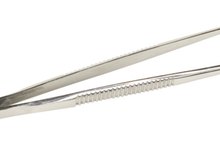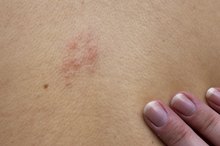What does fact checked mean?
At Healthfully, we strive to deliver objective content that is accurate and up-to-date. Our team periodically reviews articles in order to ensure content quality. The sources cited below consist of evidence from peer-reviewed journals, prominent medical organizations, academic associations, and government data.
The information contained on this site is for informational purposes only, and should not be used as a substitute for the advice of a professional health care provider. Please check with the appropriate physician regarding health questions and concerns. Although we strive to deliver accurate and up-to-date information, no guarantee to that effect is made.
How to Remove a Tick in a Navel
Ticks are blood-sucking parasites that carry disease, the most common of which is Lyme disease 1. Ticks that manage to hide themselves in a hard-to-reach area, such as the navel, can be difficult to locate and hard to remove. It's important to remove the tick whole to reduce chances of infection. Drowning the tick in a pill jar with rubbing alcohol will kill and preserve it for taking to a doctor for tests, if recommended.
If you are experiencing serious medical symptoms, seek emergency treatment immediately.
Spread the skin around the navel for a better view inside the cavity, using a flashlight to locate the tick.
How to Get Rid of Ticks That Have Burrowed Under the Skin
Learn More
Grasp the tick with tweezers as close as possible to the skin inside the navel where it has attached. If the tick's head is not buried in the skin, try to grab it by the head. Otherwise, grab the tick by the body.
Pull back gently and firmly with the tweezers and continue exerting pressure to force the tick to release its grasp. This may take several minutes, but eventually the tick will instinctively relase its grip on the skin rather than risk having its head torn off.
How to Get an Embedded Tick Out
Learn More
Inspect the tick to verify that it is in one piece.
Drop the tick into an empty pill bottle and fill halfway with alcohol, then seal the lid.
Swab the tick bite area with a cotton swab dipped in alcohol. Watch for redness and any signs of infection.
Contact a doctor to discuss whether the tick should be tested for disease. Lyme disease is caused by a bacteria harbored in ticks 1. Although the disease has been reported throughout the United States, it is prevalent mainly in the Northeast.
Warnings
Don't attempt to smother a tick with petroleum jelly. This old wives' tale has been proven ineffective, as ticks can still obtain enough oxygen to continue feeding and potentially spreading diesase to the host.
Related Articles
References
- CDC lyme disease information
- Guide to tick removal
- Centers for Disease Control and Prevention (CDC). Lyme Disease. CDC.gov.
- Centers for Disease Control and Prevention (CDC) staff. Tick Borne Diseases of the United States. CDC.gov.
- Centers for Disease Control and Prevention (CDC) staff. Overview of Tickborne Diseases. CDC.gov.
- Johns Hopkins Medicine, Rheumatology staff. What to do After a Tick Bite. Johns Hopkinsrheumatology.org.
- Mayo Clinic staff. Patient Care and Health Info. Tick Bites: First Aid. Mayo Clinic.org.
- Ostfeld, R. (2018) 8 Facts About the Ecology of Lyme. The Cary Institute of Ecosystem Studies. Caryinstitute.org.
- Zecken de Das Infoportal. About Ticks. Zecken.de.
Warnings
- Don't attempt to smother a tick with petroleum jelly. This old wives' tale has been proven ineffective, as ticks can still obtain enough oxygen to continue feeding and potentially spreading diesase to the host.
Writer Bio
James Clark began his career in 1985. He has written about electronics, appliance repair and outdoor topics for a variety of publications and websites. He has more than four years of experience in appliance and electrical repairs. Clark holds a bachelor's degree in political science.








